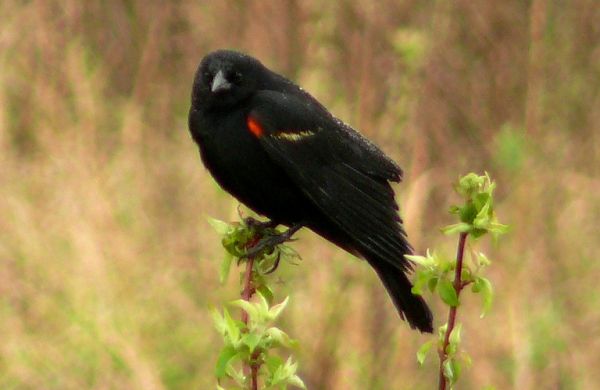
Perhaps my greatest handicap as a birder, aside from not driving, the whole being lazy thing, and the poor eyesight, is my +10 weakness against sun. I’ll stand in the cold and damp on, say, a pelagic trip until I just about fall over, hoping for one more good alcid. But even a moderate amount of sun causes me to wilt and turn pink, despite my copious investment in SPF 100 sunscreen and floppy hats. Also, for some reason, I have a mental block about carrying bottled water.
That’s all well and good if I want to be the world’s premier duck-watcher (and why not? Ducks are great!) but most of the passerines I encounter day-to-day are quite prissy about even a little rain. So that doesn’t always work out so well.
But once it’s been raining for days on end, a bird’s gotta do what a bird’s gotta do. And sometimes, as when I visited my parents at the beginning of the month, what a bird’s gotta do is visit a feeder and grab a snack.
Result — a series of breakfast-table and front-porch observations of damp birds.
The Ruby-throated Hummingbirds seemed to be holding up the best, which didn’t really surprise me: if I was branding pick-up trucks I would use a hummingbird as the logo, they’re that tough. They have to be. With plenty of honeysuckle, bee balm, and other blooms in my parents’ festive front yard, the Ruby-throats just carried on like it ain’t no thing. I admire them.
The American Goldfinches* were also hanging in there, visiting the window feeder steadily except in the worst of the downpour. The Purple Finches were less sanguine and more puffed up, sticking to the trees close to the feeder to minimize their exposure. The Rose-breasted Grosbeaks chose a more sheltered location but that meant they had to fly farther for their meals; they would arrive with slick head-feathers and fill up before retreating again.
Worst off were the Red-winged Blackbirds. It seems odd for a species so associated with ponds and sloughs that they are almost honorary water-birds, but actual exposure water made them notably ragged. In a bird that is normally so sleek as a male Red-wing (and these were all males) the clumped and spiky wet-feather look was definitely a makeover Don’t. And perhaps this is rampant anthropomorphization, but I suspected that these birds — in the season when they had to look their best for their genes’ sake — were pretty downcast about the situation.
With so much less at stake than them, I should probably just pony up for the SPF 150, or whatever is the strongest sunscreen they make now.
Photo by Ben Carlisle, used under a Creative Commons share-alike license.
*Conversation with a non-birder:
“Hey Chuk, what bird is that?”
“I don’t know.”
“Yes you do, come on.”
“I don’t know, Carrie.”
“It’s a Red-winged Blackbird!”
*Carrie leaves room, returns*
“Carrie, I saw a Black-winged Yellowbird!” (laughs at me)











Love the rainy-day blackbird! Whenever it’s wet, here, I get quite the wet bird parade at my feeder — the house sparrows and crows always look the most miserable, here. Especially the crows. They sit and sulk, with big beads of water dripping down their beaks. It’s tragic!
Consider moving to Germany. Birder here have had little choice over the last 1.5 years but to bird in unfavourable weather conditions, which means too cold, too cloudy, too rainy, too windy. This hasn’t kept us from finding and enjoying Smew, which means that you – as a premier duck-watcher -would find conditions here to be overall ideal.